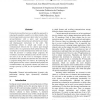Free Online Productivity Tools
i2Speak
i2Symbol
i2OCR
iTex2Img
iWeb2Print
iWeb2Shot
i2Type
iPdf2Split
iPdf2Merge
i2Bopomofo
i2Arabic
i2Style
i2Image
i2PDF
iLatex2Rtf
Sci2ools
HPCA
2000
IEEE
2000
IEEE
Dynamic Cluster Assignment Mechanisms
Clustered microarchitectures are an effective approach to reducing the penalties caused by wire delays inside a chip. Current superscalar processors have in fact a two-cluster microarchitecture with a naive code partitioning approach: integer instructions are allocated to one cluster and floating-point instructions to the other. This partitioning scheme is simple and results in no communications between the two clusters (just through memory) but it is in general far from optimal because the workload is not evenly distributed most of the time. In fact, when the processor is running integer programs, the workload is extremely unbalanced since the FP cluster is not used at all. In this work we investigate run-time mechanisms that dynamically distribute the instructions of a program among these two clusters. By optimizing the trade-off between inter-cluster communication penalty and workload balance, the proposed schemes can achieve an average speed-up of 36% for the SpecInt95 benchmark s...
Code Partitioning Approach | Current Superscalar Processors | Distributed And Parallel Computing | HPCA 2000 | Workload |
| Added | 31 Jul 2010 |
| Updated | 31 Jul 2010 |
| Type | Conference |
| Year | 2000 |
| Where | HPCA |
| Authors | Ramon Canal, Joan-Manuel Parcerisa, Antonio González |
Comments (0)

